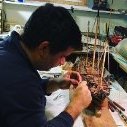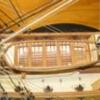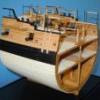MORE HANDBOOKS ARE ON THEIR WAY! We will let you know when they get here.
×
-
Posts
1,197 -
Joined
-
Last visited
Reputation Activity
-
 Stuntflyer got a reaction from yvesvidal in Sloop Speedwell 1752 by Stuntflyer (Mike) - Ketch Rigged Sloop - POF
Stuntflyer got a reaction from yvesvidal in Sloop Speedwell 1752 by Stuntflyer (Mike) - Ketch Rigged Sloop - POF
Wing transom and quarter panels
The wing transom is made from 5/16" sheet. Using the template from the plan sheet, I cut out the basic shape and then milled the four angled notches. The templates for the remaining curve shape (forming that parallelogram shape) are on the plan sheet as well. I just copied what Chuck has described in his build log on page 8, post #228. The wing transom was pinned with 24 gauge wire and glued to the deadwood. The pinning was done to make it easier to set the height of each end and fore/aft positioning without having to worry about it sliding back and forth at the same time.
After the wing transom was installed I started work on the two quarter panels which attach to the wing transom. What is important to note is that the cant frames should be fully faired prior to installing the quarter panels. I worked on this until I got a smooth transition between the last aft cant and the quarter panel. Once that was done, I glued the panels in place.
Mike
-
 Stuntflyer got a reaction from yvesvidal in Sloop Speedwell 1752 by Stuntflyer (Mike) - Ketch Rigged Sloop - POF
Stuntflyer got a reaction from yvesvidal in Sloop Speedwell 1752 by Stuntflyer (Mike) - Ketch Rigged Sloop - POF
Happy Thanksgiving, everyone!
I'm finally over a bad cold which prevented me from fairing those aft cant frames sooner. With so much wood to remove, I decided to stay with the adhesive backed 80 grit sandpaper until final cleanup. No doubt AYC would have been much easier to deal with than boxwood. Still, no complaints!
Mike
-
 Stuntflyer got a reaction from FrankWouts in Sloop Speedwell 1752 by Stuntflyer (Mike) - Ketch Rigged Sloop - POF
Stuntflyer got a reaction from FrankWouts in Sloop Speedwell 1752 by Stuntflyer (Mike) - Ketch Rigged Sloop - POF
I've been moving right along on the aft cant frames. Just like the fore cants, there is a long span between the upper and lower attachments which results in some flexing. To stiffen things up I placed chocks between the frames. This will help greatly to keep the frames from breaking loose while fairing. The chocks were placed in the area between upper wale and the lower planking strake. They will be completely hidden.
Mike
-
 Stuntflyer got a reaction from TomShipModel in Sloop Speedwell 1752 by Stuntflyer (Mike) - Ketch Rigged Sloop - POF
Stuntflyer got a reaction from TomShipModel in Sloop Speedwell 1752 by Stuntflyer (Mike) - Ketch Rigged Sloop - POF
Cant frames (aft)
Framing continues with the install of aft cant #24. This is basically a repeat of what was done with the fore cants. Just less work overall. Anyway, here you go.
Mike
-
 Stuntflyer got a reaction from GioMun in Sloop Speedwell 1752 by Stuntflyer (Mike) - Ketch Rigged Sloop - POF
Stuntflyer got a reaction from GioMun in Sloop Speedwell 1752 by Stuntflyer (Mike) - Ketch Rigged Sloop - POF
In spite of a mild case of vertigo, I managed to fair most of the port side frames. I purposely left the last 2 or 3 aft most frames partially faired. I recommend doing that in order to avoid any chance of over fairing when there are no additional frames to guide you. So, I will wait until I have some aft cant frames installed before I do any more fairing.
I shot these photos to give you an idea of just how much wood needs to be removed. Judging from this, I am sure that the cants will require even more work.
Mike
-
 Stuntflyer got a reaction from GioMun in Sloop Speedwell 1752 by Stuntflyer (Mike) - Ketch Rigged Sloop - POF
Stuntflyer got a reaction from GioMun in Sloop Speedwell 1752 by Stuntflyer (Mike) - Ketch Rigged Sloop - POF
Square tuck
I wanted to give this a try at least once before making use of the laser cut versions. #1. I copied the angle from the laser cut piece onto the joined strips. #2. The frame was made and set parallel with the angled line. #3. The curves were done with the spindle sander and disc sander along with a bit of hand work. #4. Almost ready to place on the ship. I Still needed to taper the frame.
The most difficult part was trying to get symmetry between the two sides. It's not perfect, but certainly close enough. I was kicking myself when I noticed that the top of the port side square tuck is 1/64" lower at the stern post compared to the other one. Of course this won't be seen once the moulding is on. I left the outer area of the frames without any tapering. There is a tiny filler plank that goes between the tuck and the first strake. I will wait until that's on the ship, so I can sand that area all at the same time.
Anyway only one shot at it for this result.
Mike
-
 Stuntflyer got a reaction from yvesvidal in Sloop Speedwell 1752 by Stuntflyer (Mike) - Ketch Rigged Sloop - POF
Stuntflyer got a reaction from yvesvidal in Sloop Speedwell 1752 by Stuntflyer (Mike) - Ketch Rigged Sloop - POF
As you know, Chuck faired the hull with the top jigs in place. After supporting the hull with some planking, he was able to remove the jigs and add the fairing caps for both shape and support. Through hands on experience he knows that this approach will work out nicely. I wasn't so sure that it would work out the same for me. I was concerned that after removing the top timber jigs, I would find myself having to fair the hull a lot more. This would be quite difficult with the planking already on the hull. With that in mind, I decided to take a different approach.
I added a chock between each frame where they would be covered by planking. Adding the chocks meant that I could pull the laser cut top timber jigs (before doing any planking) while maintaining support for the frames. After adding the fairing caps, I could fair the hull more accurately at the shear. Generally this turned out to be true at least for me. There were some areas at the shear that needed more work, but an inch or so below the shear the fairing work was good. Yes, a few hours of extra work that turned out well in the end.
Notice that there is still enough room for the .025" cap rail to sit just below the top of the transom.
There was an enormous amount of work needed to fair these aft cants. It took me the better part of three days. Remember this is boxwood, not AYC. Anyway that's done now.😁
Mike
-
 Stuntflyer got a reaction from shipcarpenter in Sloop Speedwell 1752 by Stuntflyer (Mike) - Ketch Rigged Sloop - POF
Stuntflyer got a reaction from shipcarpenter in Sloop Speedwell 1752 by Stuntflyer (Mike) - Ketch Rigged Sloop - POF
Square tuck
I wanted to give this a try at least once before making use of the laser cut versions. #1. I copied the angle from the laser cut piece onto the joined strips. #2. The frame was made and set parallel with the angled line. #3. The curves were done with the spindle sander and disc sander along with a bit of hand work. #4. Almost ready to place on the ship. I Still needed to taper the frame.
The most difficult part was trying to get symmetry between the two sides. It's not perfect, but certainly close enough. I was kicking myself when I noticed that the top of the port side square tuck is 1/64" lower at the stern post compared to the other one. Of course this won't be seen once the moulding is on. I left the outer area of the frames without any tapering. There is a tiny filler plank that goes between the tuck and the first strake. I will wait until that's on the ship, so I can sand that area all at the same time.
Anyway only one shot at it for this result.
Mike
-
 Stuntflyer got a reaction from yvesvidal in Sloop Speedwell 1752 by Stuntflyer (Mike) - Ketch Rigged Sloop - POF
Stuntflyer got a reaction from yvesvidal in Sloop Speedwell 1752 by Stuntflyer (Mike) - Ketch Rigged Sloop - POF
Window sills
I will admit that these were quite tricky to make. Different angles everywhere and some trial and error was needed in order to get them just right. I probably had 3 or 4 throwaways before getting the ones you see here.
Stern frames
In order to make these, I sandwiched two roughly cut frames together with some Elmer's School Glue and then adhered the plan drawing for final shaping. This was easy enough to do with the help of the spindle sander, disk sander and scroll saw.
Transom
On top of the shear there will be a 5/32" fairing cap and a 1/4" cap rail that sits on top of that. The two pieces will add a total of about 3/32" more height to the top of the shear. I wouldn't want the cap rail to protrude above the top edge of the transom. With that in mind, I decided to fair the quarter deck shear before adding the transom. This way I could check the clearance before adding the transom. It was really just a matter of getting that small triangular piece taken down to the right height while fairing the shear.
I added the 5/32" fairing cap for the quarter deck and faired the outer hull using the cap as a guide.
Mike
-
 Stuntflyer got a reaction from yvesvidal in Sloop Speedwell 1752 by Stuntflyer (Mike) - Ketch Rigged Sloop - POF
Stuntflyer got a reaction from yvesvidal in Sloop Speedwell 1752 by Stuntflyer (Mike) - Ketch Rigged Sloop - POF
Framing (final pieces)
I have finally finished all of the framing. About nine months to do them all including about 160 milled scarph joints. It certainly feels like a milestone. Though mostly done, I still need to do some minor cleanup fairing, especially where the cants transition into the deadwood.
FYI: Here is the fit that I was shooting for when adding the last frame, #29.
Mike
-
 Stuntflyer got a reaction from FrankWouts in Sloop Speedwell 1752 by Stuntflyer (Mike) - Ketch Rigged Sloop - POF
Stuntflyer got a reaction from FrankWouts in Sloop Speedwell 1752 by Stuntflyer (Mike) - Ketch Rigged Sloop - POF
As you know, Chuck faired the hull with the top jigs in place. After supporting the hull with some planking, he was able to remove the jigs and add the fairing caps for both shape and support. Through hands on experience he knows that this approach will work out nicely. I wasn't so sure that it would work out the same for me. I was concerned that after removing the top timber jigs, I would find myself having to fair the hull a lot more. This would be quite difficult with the planking already on the hull. With that in mind, I decided to take a different approach.
I added a chock between each frame where they would be covered by planking. Adding the chocks meant that I could pull the laser cut top timber jigs (before doing any planking) while maintaining support for the frames. After adding the fairing caps, I could fair the hull more accurately at the shear. Generally this turned out to be true at least for me. There were some areas at the shear that needed more work, but an inch or so below the shear the fairing work was good. Yes, a few hours of extra work that turned out well in the end.
Notice that there is still enough room for the .025" cap rail to sit just below the top of the transom.
There was an enormous amount of work needed to fair these aft cants. It took me the better part of three days. Remember this is boxwood, not AYC. Anyway that's done now.😁
Mike
-
 Stuntflyer reacted to glbarlow in HMS Winchelsea 1764 by glbarlow - FINISHED - 1:48
Stuntflyer reacted to glbarlow in HMS Winchelsea 1764 by glbarlow - FINISHED - 1:48
Making some progress these past few days. More detailed post later but just one photo for a quick update on forecastle work.
-
 Stuntflyer got a reaction from Freebird in HM Cutter Cheerful 1806 by Stuntflyer (Mike) - FINISHED - 1:48 scale
Stuntflyer got a reaction from Freebird in HM Cutter Cheerful 1806 by Stuntflyer (Mike) - FINISHED - 1:48 scale
The making and fitting of the bowsprit proved to be a very interesting project along with a few challenges along the way. .
The square stick was marked off on opposite sides every two inches for the length of the bowsprit. Using the plan as a guide a 7-10-7 tapered template was used to mark the bowsprit width at each of the 2 inch locations. Then a ships curve was used to join these marks along the entire length of the bowsprit. The disc sander was used to remove the wood outside the tapered line. The process was repeated on the two remaining sides.
Using my hobby vise, which now has removable rubber jaws, the bowsprit was filed down to achieve the octagon shape. Care was taken not to file past the lines while keeping the surfaces as flat as possible.
The bowsprit was rounded off, a task easily accomplished using the "shoe shine" technique with sandpaper. So far so good, I thought. .
Fitting the bowsprit into the hull proved to be a very time consuming process. The bowsprit has to be slid over the deck fittings at a downward angle. Once clear it can be lowered into the bowsprit bit. Problem was, the bowsprit was rubbing on the bottom of the pin rail at the bow making it difficult to move it forward. I had no choice other than to remove the pin rail. Once the hole was completed, the end of the bowsprit could be lowered into the bit. The hole shape was close though there was a bit too much slop where it exited the hawse plate. This was unacceptable, so I removed the plate and made a new one after the bowsprit was affixed to the bit. This proved to be another challenging task as the plate becomes very fragile as the hole is enlarged. I fixed the hole fit inside the hull with some filler and paint. I added a new pin rail from thinner 1/32" sheet which now sits flush with the cap rail.
It goes to show that there must be some measurement which was slightly off thus making it difficult to do what would seem to be a straight forward task. Anyway, I'm happy with the result overall.
-
 Stuntflyer got a reaction from davec in Sloop Speedwell 1752 by Stuntflyer (Mike) - Ketch Rigged Sloop - POF
Stuntflyer got a reaction from davec in Sloop Speedwell 1752 by Stuntflyer (Mike) - Ketch Rigged Sloop - POF
As you know, Chuck faired the hull with the top jigs in place. After supporting the hull with some planking, he was able to remove the jigs and add the fairing caps for both shape and support. Through hands on experience he knows that this approach will work out nicely. I wasn't so sure that it would work out the same for me. I was concerned that after removing the top timber jigs, I would find myself having to fair the hull a lot more. This would be quite difficult with the planking already on the hull. With that in mind, I decided to take a different approach.
I added a chock between each frame where they would be covered by planking. Adding the chocks meant that I could pull the laser cut top timber jigs (before doing any planking) while maintaining support for the frames. After adding the fairing caps, I could fair the hull more accurately at the shear. Generally this turned out to be true at least for me. There were some areas at the shear that needed more work, but an inch or so below the shear the fairing work was good. Yes, a few hours of extra work that turned out well in the end.
Notice that there is still enough room for the .025" cap rail to sit just below the top of the transom.
There was an enormous amount of work needed to fair these aft cants. It took me the better part of three days. Remember this is boxwood, not AYC. Anyway that's done now.😁
Mike
-
 Stuntflyer got a reaction from TomShipModel in Sloop Speedwell 1752 by Stuntflyer (Mike) - Ketch Rigged Sloop - POF
Stuntflyer got a reaction from TomShipModel in Sloop Speedwell 1752 by Stuntflyer (Mike) - Ketch Rigged Sloop - POF
Window sills
I will admit that these were quite tricky to make. Different angles everywhere and some trial and error was needed in order to get them just right. I probably had 3 or 4 throwaways before getting the ones you see here.
Stern frames
In order to make these, I sandwiched two roughly cut frames together with some Elmer's School Glue and then adhered the plan drawing for final shaping. This was easy enough to do with the help of the spindle sander, disk sander and scroll saw.
Transom
On top of the shear there will be a 5/32" fairing cap and a 1/4" cap rail that sits on top of that. The two pieces will add a total of about 3/32" more height to the top of the shear. I wouldn't want the cap rail to protrude above the top edge of the transom. With that in mind, I decided to fair the quarter deck shear before adding the transom. This way I could check the clearance before adding the transom. It was really just a matter of getting that small triangular piece taken down to the right height while fairing the shear.
I added the 5/32" fairing cap for the quarter deck and faired the outer hull using the cap as a guide.
Mike
-
 Stuntflyer got a reaction from FrankWouts in Sloop Speedwell 1752 by Stuntflyer (Mike) - Ketch Rigged Sloop - POF
Stuntflyer got a reaction from FrankWouts in Sloop Speedwell 1752 by Stuntflyer (Mike) - Ketch Rigged Sloop - POF
Framing (final pieces)
I have finally finished all of the framing. About nine months to do them all including about 160 milled scarph joints. It certainly feels like a milestone. Though mostly done, I still need to do some minor cleanup fairing, especially where the cants transition into the deadwood.
FYI: Here is the fit that I was shooting for when adding the last frame, #29.
Mike
-
 Stuntflyer got a reaction from TomShipModel in Sloop Speedwell 1752 by Stuntflyer (Mike) - Ketch Rigged Sloop - POF
Stuntflyer got a reaction from TomShipModel in Sloop Speedwell 1752 by Stuntflyer (Mike) - Ketch Rigged Sloop - POF
Happy Thanksgiving, everyone!
I'm finally over a bad cold which prevented me from fairing those aft cant frames sooner. With so much wood to remove, I decided to stay with the adhesive backed 80 grit sandpaper until final cleanup. No doubt AYC would have been much easier to deal with than boxwood. Still, no complaints!
Mike
-
 Stuntflyer got a reaction from davec in Sloop Speedwell 1752 by Stuntflyer (Mike) - Ketch Rigged Sloop - POF
Stuntflyer got a reaction from davec in Sloop Speedwell 1752 by Stuntflyer (Mike) - Ketch Rigged Sloop - POF
I've been moving right along on the aft cant frames. Just like the fore cants, there is a long span between the upper and lower attachments which results in some flexing. To stiffen things up I placed chocks between the frames. This will help greatly to keep the frames from breaking loose while fairing. The chocks were placed in the area between upper wale and the lower planking strake. They will be completely hidden.
Mike
-
 Stuntflyer got a reaction from FrankWouts in Sloop Speedwell 1752 by Stuntflyer (Mike) - Ketch Rigged Sloop - POF
Stuntflyer got a reaction from FrankWouts in Sloop Speedwell 1752 by Stuntflyer (Mike) - Ketch Rigged Sloop - POF
In spite of a mild case of vertigo, I managed to fair most of the port side frames. I purposely left the last 2 or 3 aft most frames partially faired. I recommend doing that in order to avoid any chance of over fairing when there are no additional frames to guide you. So, I will wait until I have some aft cant frames installed before I do any more fairing.
I shot these photos to give you an idea of just how much wood needs to be removed. Judging from this, I am sure that the cants will require even more work.
Mike
-
 Stuntflyer got a reaction from Seventynet in Sloop Speedwell 1752 by Stuntflyer (Mike) - Ketch Rigged Sloop - POF
Stuntflyer got a reaction from Seventynet in Sloop Speedwell 1752 by Stuntflyer (Mike) - Ketch Rigged Sloop - POF
As you know, Chuck faired the hull with the top jigs in place. After supporting the hull with some planking, he was able to remove the jigs and add the fairing caps for both shape and support. Through hands on experience he knows that this approach will work out nicely. I wasn't so sure that it would work out the same for me. I was concerned that after removing the top timber jigs, I would find myself having to fair the hull a lot more. This would be quite difficult with the planking already on the hull. With that in mind, I decided to take a different approach.
I added a chock between each frame where they would be covered by planking. Adding the chocks meant that I could pull the laser cut top timber jigs (before doing any planking) while maintaining support for the frames. After adding the fairing caps, I could fair the hull more accurately at the shear. Generally this turned out to be true at least for me. There were some areas at the shear that needed more work, but an inch or so below the shear the fairing work was good. Yes, a few hours of extra work that turned out well in the end.
Notice that there is still enough room for the .025" cap rail to sit just below the top of the transom.
There was an enormous amount of work needed to fair these aft cants. It took me the better part of three days. Remember this is boxwood, not AYC. Anyway that's done now.😁
Mike
-
 Stuntflyer got a reaction from KARAVOKIRIS in Sloop Speedwell 1752 by Stuntflyer (Mike) - Ketch Rigged Sloop - POF
Stuntflyer got a reaction from KARAVOKIRIS in Sloop Speedwell 1752 by Stuntflyer (Mike) - Ketch Rigged Sloop - POF
As you know, Chuck faired the hull with the top jigs in place. After supporting the hull with some planking, he was able to remove the jigs and add the fairing caps for both shape and support. Through hands on experience he knows that this approach will work out nicely. I wasn't so sure that it would work out the same for me. I was concerned that after removing the top timber jigs, I would find myself having to fair the hull a lot more. This would be quite difficult with the planking already on the hull. With that in mind, I decided to take a different approach.
I added a chock between each frame where they would be covered by planking. Adding the chocks meant that I could pull the laser cut top timber jigs (before doing any planking) while maintaining support for the frames. After adding the fairing caps, I could fair the hull more accurately at the shear. Generally this turned out to be true at least for me. There were some areas at the shear that needed more work, but an inch or so below the shear the fairing work was good. Yes, a few hours of extra work that turned out well in the end.
Notice that there is still enough room for the .025" cap rail to sit just below the top of the transom.
There was an enormous amount of work needed to fair these aft cants. It took me the better part of three days. Remember this is boxwood, not AYC. Anyway that's done now.😁
Mike
-
 Stuntflyer got a reaction from Mike Y in Sloop Speedwell 1752 by Stuntflyer (Mike) - Ketch Rigged Sloop - POF
Stuntflyer got a reaction from Mike Y in Sloop Speedwell 1752 by Stuntflyer (Mike) - Ketch Rigged Sloop - POF
As you know, Chuck faired the hull with the top jigs in place. After supporting the hull with some planking, he was able to remove the jigs and add the fairing caps for both shape and support. Through hands on experience he knows that this approach will work out nicely. I wasn't so sure that it would work out the same for me. I was concerned that after removing the top timber jigs, I would find myself having to fair the hull a lot more. This would be quite difficult with the planking already on the hull. With that in mind, I decided to take a different approach.
I added a chock between each frame where they would be covered by planking. Adding the chocks meant that I could pull the laser cut top timber jigs (before doing any planking) while maintaining support for the frames. After adding the fairing caps, I could fair the hull more accurately at the shear. Generally this turned out to be true at least for me. There were some areas at the shear that needed more work, but an inch or so below the shear the fairing work was good. Yes, a few hours of extra work that turned out well in the end.
Notice that there is still enough room for the .025" cap rail to sit just below the top of the transom.
There was an enormous amount of work needed to fair these aft cants. It took me the better part of three days. Remember this is boxwood, not AYC. Anyway that's done now.😁
Mike
-
 Stuntflyer got a reaction from GrandpaPhil in Sloop Speedwell 1752 by Stuntflyer (Mike) - Ketch Rigged Sloop - POF
Stuntflyer got a reaction from GrandpaPhil in Sloop Speedwell 1752 by Stuntflyer (Mike) - Ketch Rigged Sloop - POF
As you know, Chuck faired the hull with the top jigs in place. After supporting the hull with some planking, he was able to remove the jigs and add the fairing caps for both shape and support. Through hands on experience he knows that this approach will work out nicely. I wasn't so sure that it would work out the same for me. I was concerned that after removing the top timber jigs, I would find myself having to fair the hull a lot more. This would be quite difficult with the planking already on the hull. With that in mind, I decided to take a different approach.
I added a chock between each frame where they would be covered by planking. Adding the chocks meant that I could pull the laser cut top timber jigs (before doing any planking) while maintaining support for the frames. After adding the fairing caps, I could fair the hull more accurately at the shear. Generally this turned out to be true at least for me. There were some areas at the shear that needed more work, but an inch or so below the shear the fairing work was good. Yes, a few hours of extra work that turned out well in the end.
Notice that there is still enough room for the .025" cap rail to sit just below the top of the transom.
There was an enormous amount of work needed to fair these aft cants. It took me the better part of three days. Remember this is boxwood, not AYC. Anyway that's done now.😁
Mike
-
 Stuntflyer got a reaction from Alexander Bulimov in Sloop Speedwell 1752 by Stuntflyer (Mike) - Ketch Rigged Sloop - POF
Stuntflyer got a reaction from Alexander Bulimov in Sloop Speedwell 1752 by Stuntflyer (Mike) - Ketch Rigged Sloop - POF
As you know, Chuck faired the hull with the top jigs in place. After supporting the hull with some planking, he was able to remove the jigs and add the fairing caps for both shape and support. Through hands on experience he knows that this approach will work out nicely. I wasn't so sure that it would work out the same for me. I was concerned that after removing the top timber jigs, I would find myself having to fair the hull a lot more. This would be quite difficult with the planking already on the hull. With that in mind, I decided to take a different approach.
I added a chock between each frame where they would be covered by planking. Adding the chocks meant that I could pull the laser cut top timber jigs (before doing any planking) while maintaining support for the frames. After adding the fairing caps, I could fair the hull more accurately at the shear. Generally this turned out to be true at least for me. There were some areas at the shear that needed more work, but an inch or so below the shear the fairing work was good. Yes, a few hours of extra work that turned out well in the end.
Notice that there is still enough room for the .025" cap rail to sit just below the top of the transom.
There was an enormous amount of work needed to fair these aft cants. It took me the better part of three days. Remember this is boxwood, not AYC. Anyway that's done now.😁
Mike
-
 Stuntflyer got a reaction from dvm27 in Sloop Speedwell 1752 by Stuntflyer (Mike) - Ketch Rigged Sloop - POF
Stuntflyer got a reaction from dvm27 in Sloop Speedwell 1752 by Stuntflyer (Mike) - Ketch Rigged Sloop - POF
As you know, Chuck faired the hull with the top jigs in place. After supporting the hull with some planking, he was able to remove the jigs and add the fairing caps for both shape and support. Through hands on experience he knows that this approach will work out nicely. I wasn't so sure that it would work out the same for me. I was concerned that after removing the top timber jigs, I would find myself having to fair the hull a lot more. This would be quite difficult with the planking already on the hull. With that in mind, I decided to take a different approach.
I added a chock between each frame where they would be covered by planking. Adding the chocks meant that I could pull the laser cut top timber jigs (before doing any planking) while maintaining support for the frames. After adding the fairing caps, I could fair the hull more accurately at the shear. Generally this turned out to be true at least for me. There were some areas at the shear that needed more work, but an inch or so below the shear the fairing work was good. Yes, a few hours of extra work that turned out well in the end.
Notice that there is still enough room for the .025" cap rail to sit just below the top of the transom.
There was an enormous amount of work needed to fair these aft cants. It took me the better part of three days. Remember this is boxwood, not AYC. Anyway that's done now.😁
Mike










